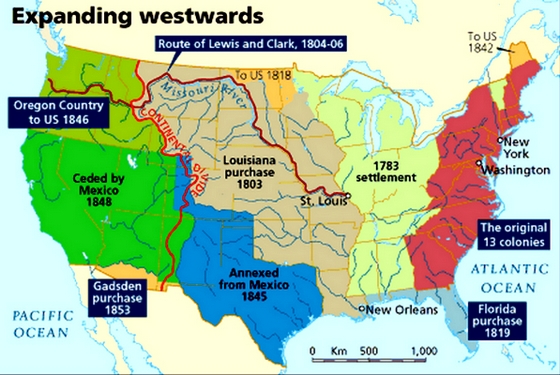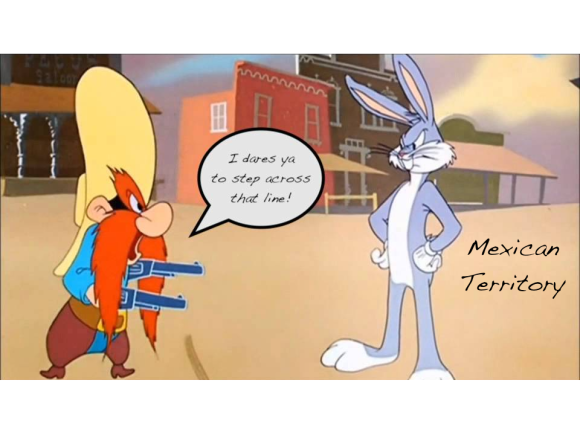Image above: Pakistani and India border guards act out nationalistic rituals to the delight of the crowds. Clearly, they have invested a lot of meaning in their borders.
In this part 3 we do some analysis and thought experiments to determine what exactly a border is. Let’s break it down. (For parts one and two of this series click here and here.)
A border is more than a line on a map. It’s a powerful statement of sovereignty. But a border, like money, does not have any reality outside of a societal belief in it. Without that belief, money is just paper or bits and bytes, and borders are just lines on a map. Borders only have significance because we agree that they do.
Furthermore, the establishment of any particular border rests on a declaration of power, not on bending to the truth of geographic necessity. These border demarcations take place in the context of historical events. Most of these historical events involve people with weapons overwhelming people with fewer weapons. That is, these borders are essentially imposed on the weaker party.

Third, the two sides of a border demarcate one system of laws from another system. They are legal divisions, not cultural. There was a time when borders marked culture, language, and religion but those days are mostly gone. I think of the ancient border of the Jordan River where people on one side would say Shibboleth but people from the other side would say Sibboleth. The wrong pronunciation would bring death. Unfortunately, there are still people today who think that political borders exist to protect their culture and language.
In short, borders are impositions on the natural world as a way of demarcating one system of laws from another system of laws. This is true of national, state, county, and municipal borders. That’s all. The moral slipperiness of borders lies in the fact that we try to make them more than they are and more than they should be.

Recently, the president tweeted “Tell the people “OUT,” and they must leave, just as they would if they were standing on your front lawn.” This is a common analogy that people use when talking about borders – private property. But borders are not property lines. In every country there is public space: roads, sidewalks, beaches, parks, etc. And although we have laws about how these public spaces can be used, you do not have to be a citizen to use them.
Also, your private property is protected because it is yours, not because of your citizenship or visa status. Even people who have never been to this country can own property here.
Finally, we have laws about privacy apart from property rights. You cannot enter someone else’s hotel room or rental car without permission or probable cause if you are in law enforcement. As far as I know, these rights are the same for citizens and non-citizens.
For these and other reasons, the get-off-my-lawn analogy is not useful when it comes to public space in America. You can’t just tell people to get out of the country unless you go through a lawful process of deportation, which is something that is being skipped these days.
So, if borders are not established through mutual consent, if they do not follow existing geographical or cultural divisions, if they are not about property rights, then what are they for? We have one more possibility. They are for defense, a way of making sure that aggressors and criminals stay out and safe people can come in.
Intuitively, this seems right. Invasion by hostile forces is always a possibility across borders, whether that invasion comes in the form of smuggling, raiding, or military action. When Russian military planes fly over our airspace, or when American fishermen fish in Canada’s waters, these are considered hostile acts and may be met with force, even if no one was killed or injured.
But this doesn’t get to the heart of borders either. What happens when a police car from one county drives into another county? Nothing. What about when a Kansas trucker brings goods to Missouri? Again, nothing. Or what happens when you drive from France into Germany. Nothing. And the reason nothing happens at these borders is not because these borders are not real. They are as real as any border. Nothing happens because there are ongoing agreements about freedom of movement that were established by law. You have simply moved from one system of laws into another system.
We don’t really realize how recent these systems of passports, visas, and immigration restrictions are. Many of our ancestors immigrated here not only without permission, but without any documents. Even the famous Ellis Island entry point was not mandatory for immigrants to pass through. If you happened to be on a ship that landed in Virginia or Maine or almost anywhere else, you just landed, got off the boat, and you were in. No one asked for papers because there were no papers. Furthermore, in the southwest, you might be born in Mexico, raised in the Republic of Texas, and married in The US without ever leaving your hometown. My point in taking this historical “rabbit trail” is to illustrate that all of these issues are politically and socially constructed. They are ours to construct and ours to deconstruct. There is no natural law that determines the shape of countries, or residency, or citizenship. We decide what borders mean. There is no one forcing us to make our borders resemble the Great Wall of China or the the Korean DMZ. But before fear builds walls on the land, it builds them in our minds.
My point in taking this historical “rabbit trail” is to illustrate that all of these issues are politically and socially constructed. They are ours to construct and ours to deconstruct. There is no natural law that determines the shape of countries, or residency, or citizenship. We decide what borders mean. There is no one forcing us to make our borders resemble the Great Wall of China or the the Korean DMZ. But before fear builds walls on the land, it builds them in our minds.
